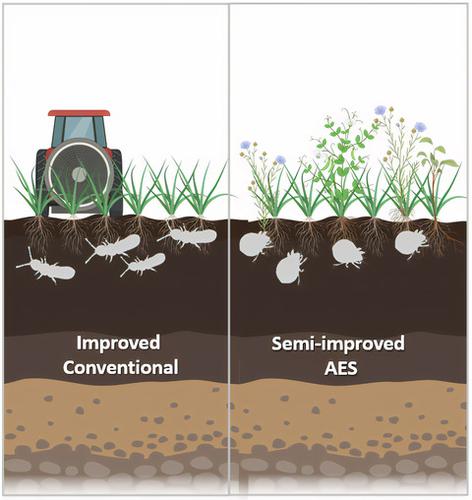当前位置:
X-MOL 学术
›
J. Appl. Ecol.
›
论文详情
Our official English website, www.x-mol.net, welcomes your
feedback! (Note: you will need to create a separate account there.)
Upland grassland habitats and agri-environment schemes change soil microarthropod abundance
Journal of Applied Ecology ( IF 5.0 ) Pub Date : 2021-05-26 , DOI: 10.1111/1365-2664.13933 Amy Arnott 1 , Gillian Riddell 1 , Mark Emmerson 1, 2 , Tancredi Caruso 3 , Neil Reid 1, 2
中文翻译:

高地草原栖息地和农业环境计划改变了土壤微节肢动物的丰度
更新日期:2021-05-26
Journal of Applied Ecology ( IF 5.0 ) Pub Date : 2021-05-26 , DOI: 10.1111/1365-2664.13933 Amy Arnott 1 , Gillian Riddell 1 , Mark Emmerson 1, 2 , Tancredi Caruso 3 , Neil Reid 1, 2
Affiliation

|
- Agricultural intensification is a major driver of biodiversity loss, with the implementation of Agri-Environment Schemes (AESs) being a widespread policy designed to prevent further loss, and to maintain or restore ecosystem health. Upland grassland soils are disproportionately impacted by intensification including drainage, artificial fertiliser use, compaction and erosion while the effect of AES management on below-ground microarthropods, which mediate a range of ecosystem processes, is largely unknown.
- This study tested the effects of AES management of upland grasslands on microarthropod communities using a large-scale factorial field experiment. The study focused on microarthropods with distinct taxa-specific responses observed.
- Oribatid mite abundance was associated with wetter, more extensive pastures with native grasses characteristic of semi-improved grassland managed by AESs, whereas Collembola abundance was associated with drier, more intense, reseeded (Lolium perenne dominated) pastures characteristic of conventionally managed improved grasslands.
- Differences in taxa responses may be driven by life-history traits and resilience to disturbance. There was no net effect of management, habitat or their interaction on total microarthropod family diversity or abundance.
- Synthesis and Applications. Results from this study suggest that in floristically simple upland agroecosystems the impact of agri-environment measures on below-ground soil biota are context-dependent (differing between contrasting grassland types), and taxa-specific, rather than leading to general increases in biodiversity per se, and the responses of soil microarthropods are driven by environmental variation caused by overall management of grassland fields. Measures should aim to increase the availability of areas of semi-improved grassland, with native plant mixtures, adjacent to improved grasslands, to maximise the habitats available to soil microarthropods.
中文翻译:

高地草原栖息地和农业环境计划改变了土壤微节肢动物的丰度
- 农业集约化是生物多样性丧失的主要驱动因素,农业环境计划 (AES) 的实施是一项广泛的政策,旨在防止进一步丧失,并维持或恢复生态系统健康。高地草原土壤受到包括排水、人工肥料使用、压实和侵蚀在内的集约化影响不成比例,而 AES 管理对调节一系列生态系统过程的地下微节肢动物的影响在很大程度上是未知的。
- 本研究使用大规模因子田间试验测试了高地草原的 AES 管理对微节肢动物群落的影响。该研究的重点是观察到具有不同分类群特异性反应的微节肢动物。
- Oribatid 螨丰度与更湿润、更广泛的牧场有关,该牧场具有由 AES 管理的半改良草地的原生草特征,而弹尾目丰度与更干燥、更密集、重新播种(黑麦草占主导地位)的牧场有关,这些牧场具有传统管理的改良草地的特征。
- 分类群反应的差异可能是由生活史特征和对干扰的恢复力驱动的。管理、栖息地或其相互作用对微节肢动物总家族多样性或丰度没有净影响。
- 合成与应用。这项研究的结果表明,在植物区系简单的高地农业生态系统中,农业环境措施对地下土壤生物群的影响是依赖于环境的(不同草原类型之间不同)和特定类群,而不是导致生物多样性的普遍增加。 se,土壤微节肢动物的反应是由草地整体管理引起的环境变化驱动的。措施应旨在增加半改良草地区域的可用性,与改良草地相邻的本地植物混合物,以最大限度地扩大土壤微节肢动物可用的栖息地。











































 京公网安备 11010802027423号
京公网安备 11010802027423号